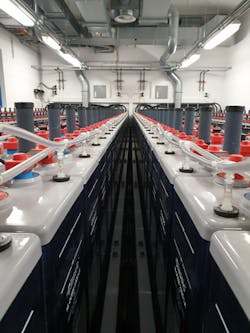With energy storage expected to double this year and triple in 2020, researchers are working to boost lead battery performance for its use in renewable energy integration and electric vehicles.
The Consortium for Battery Innovation (CBI), a global research organization that funds innovation in lead batteries, has developed a roadmap for growth.
Advanced lead batteries offer cost and sustainability advantages, said Alistair Davidson, director, CBI. They’re generally less expensive than alternatives and are recycled at a rate of 99%.
It’s also possible to sell old batteries into the recycling market instead of paying to dispose of them. “You can put them back in recycling loops at the end of life, making money,” said Matthew Raiford, technical manager, CBI.
While lead batteries are too heavy to be the main batteries for EVs, 12-volt lead batteries are often used as backup for the cars. If lithium ion or other batteries fail in cars, the lead backup batteries give drivers enough power to pull to the side of the road, he said.
Found in most EVs
For that reason they’re found in most EVs, and the growth in EVs will boost the lead battery market.
In addition, advanced lead batteries require less energy to produce, Raiford said. About 100 to 150 kWh of energy is required for each kW of battery production.
Energy storage at the utility level is expected to increase by 10 times by 2030, Davidson said. Lead batteries can be used for transmission and distribution reserves, providing backup energy storage at the grid level.
Batteries for homes is another growing market, said Davidson.
CBI’s goal is to improve the life cycle of batteries for utility and renewable energy applications, said Raiford. The life cycle represents how many times they can be charged and discharged.
CBI wants to increase battery cycle life by five times by 2022, achieving 5,000 cycles, creating lower operating costs, “a key parameter for utility and renewable energy applications,” said the roadmap.
Demand for energy storage is being driven by governments globally that are setting ambitious decarbonization and electrification goals, said the roadmap. The massive growth can’t be met by one technology alone.
Role of the lead battery in microgrids
Davidson sees demand growing across the globe for lead batteries in microgrids, as well.
The EcoVillage at Missouri University of Science & Technology offers an example of lead battery use in microgrids.
Homes on campus are being used as living laboratories for studying renewable energy and storage. Research focuses on the performance of advanced lead batteries in small solar microgrids and on sharing energy at the neighborhood level.
Another lead battery is part of a microgrid on Fair Isle, a remote Scottish Island that was previously powered by a diesel generator and some wind power, but subject to night time blackouts. Fair Isle now has power 24/7 from a microgrid made up of 50 kW of PV solar panels and a 0.23 MW battery storage system.
The microgrids with advanced lead batteries often replace diesel systems in remote locations in Africa and Latin America, Davidson said.
“This has drastically reduced the reliance on petroleum. The batteries provide highly sustainable electrification to areas that have never seen it before,” he said.
Lead batteries provide 75% of global rechargeable energy storage, said the roadmap.
Increasing demand for battery energy storage has spurred a race to create innovative batteries. And CBI wants to be a player in the race.
“The vast growth in demand for battery energy storage is fueling the race to design and deliver ever more impressive and innovative batteries. As countries rush to reduce their carbon dependency, battery energy storage is set to be one of the defining technologies of the century,” said the roadmap.
Track news about innovations in energy storage. Subscribe to the free Microgrid Knowledge newsletter.








